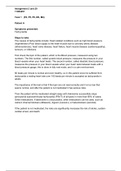11053457
Task 1 (P4, P5, P6, M3, M4)
Patient A
Symptoms presented:
Tachycardia
Steps to take:
The causes of tachycardia include: Heart-related conditions such as high blood pressure
(hypertension) Poor blood supply to the heart muscle due to coronary artery disease
(atherosclerosis), heart valve disease, heart failure, heart muscle disease (cardiomyopathy),
tumours, or infections.
First check the bpm of the patient, which is the Blood pressure, measured using two
numbers. The first number, called systolic blood pressure, measures the pressure in your
blood vessels when your heart beats. The second number, called diastolic blood pressure,
measures the pressure in your blood vessels when your heart rests between beats with a
blood pressure gauge, this is done in fully rest mode, and in a calm environment.
60 beats per minute is normal and even healthy, so in this patient since he suffered from
tachycardia a resting heart rate over 100 beats per minute is accepted as tachycardia in
adults.
The importance of the test is that if the bpm are not read correctly and it is too low that
seems normal, and after the patient is not medicated it has serious risks.
Than the patient will be medicated straight away with Adenosine successfully stops
paroxysmal supraventricular tachycardia (PSVT) of all types in more than 90% of cases.
Other medications: If adenosine is unsuccessful, other medications can be used, such as
calcium channel blockers (diltiazem), digoxin (Lanoxin), or beta-blockers (esmolol).
If the patient is not medicated, the risks are significantly increases the risk of stroke, sudden
cardiac arrest, and death.










